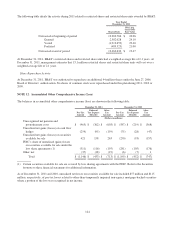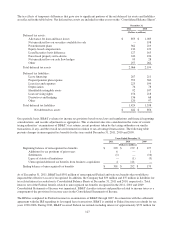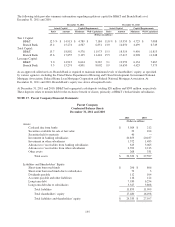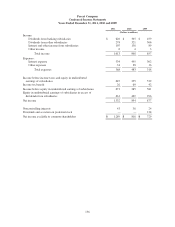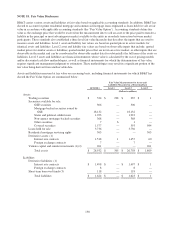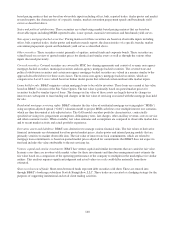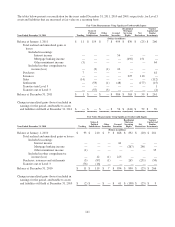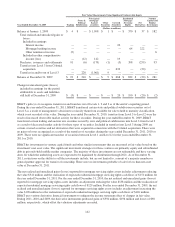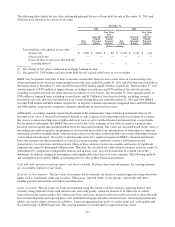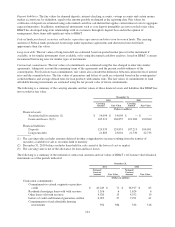BB&T 2011 Annual Report Download - page 134
Download and view the complete annual report
Please find page 134 of the 2011 BB&T annual report below. You can navigate through the pages in the report by either clicking on the pages listed below, or by using the keyword search tool below to find specific information within the annual report.Legal Proceedings
The nature of the business of BB&T’s banking and other subsidiaries ordinarily results in a certain amount of claims, litigation,
investigations and legal and administrative cases and proceedings, all of which are considered incidental to the normal conduct
of business. BB&T believes it has meritorious defenses to the claims asserted against it in its currently outstanding legal
proceedings and, with respect to such legal proceedings, intends to continue to defend itself vigorously, litigating or settling
cases according to management’s judgment as to what is in the best interests of BB&T and its shareholders.
The Company is a defendant in three separate cases primarily challenging the Company’s daily ordering of debit
transactions posted to customer checking accounts for the period from 2003 to 2010. The plaintiffs have requested class
action treatment, however, no class has been certified. The court initially denied motions by the Company to dismiss these
cases and compel them to be submitted to individual arbitration. The Company then filed appeals in all three matters.
There have been numerous subsequent procedural developments, including an appeal to the United States Supreme Court
in one matter which resulted in a decision that benefited the Company. Nevertheless, at present the issues raised by these
motions and/or appeals remain undecided. If the motions or appeals are ultimately granted, they would preclude class
action treatment. Even if those appeals are denied, the Company believes it has meritorious defenses against these matters,
including class certification. Because of these appeals, and because these cases are in preliminary proceedings and no
damages have been specified, no specific loss or range of loss can currently be determined.
On at least a quarterly basis, BB&T assesses its liabilities and contingencies in connection with outstanding legal
proceedings utilizing the latest information available. For those matters where it is probable that BB&T will incur a loss
and the amount of the loss can be reasonably estimated, BB&T records a liability in its consolidated financial statements.
These legal reserves may be increased or decreased to reflect any relevant developments on at least a quarterly basis. For
other matters, where a loss is not probable or the amount of the loss is not estimable, BB&T has not accrued legal
reserves. While the outcome of legal proceedings is inherently uncertain, based on information currently available, advice
of counsel and available insurance coverage, BB&T’s management believes that its established legal reserves are adequate
and the liabilities arising from BB&T’s legal proceedings will not have a material adverse effect on the consolidated
financial position, consolidated results of operations or consolidated cash flows of BB&T. However, in the event of
unexpected future developments, it is possible that the ultimate resolution of these matters, if unfavorable, may be
material to BB&T’s consolidated financial position, consolidated results of operations or consolidated cash flows.
NOTE 16. Regulatory Requirements and Other Restrictions
Branch Bank and BB&T FSB are required by the Board of Governors of the Federal Reserve System to maintain reserve
balances in the form of vault cash or deposits with the Federal Reserve Bank based on specified percentages of certain
deposit types, subject to various adjustments. At December 31, 2011, the net reserve requirement amounted to $237
million.
Branch Bank is subject to laws and regulations that limit the amount of dividends it can pay. In addition, both BB&T and
Branch Bank are subject to various regulatory restrictions relating to the payment of dividends, including requirements to
maintain capital at or above regulatory minimums, and to remain “well-capitalized” under the prompt corrective action
regulations. BB&T does not expect that any of these laws, regulations or policies will materially affect the ability of
Branch Bank to pay dividends.
BB&T is subject to various regulatory capital requirements administered by the Federal banking agencies. Failure to meet
minimum capital requirements can initiate certain mandatory—and possibly additional discretionary—actions by
regulators that, if undertaken, could have a direct material effect on BB&T’s financial statements. Under capital adequacy
guidelines and the regulatory framework for prompt corrective action, the Corporation must meet specific capital
guidelines that involve quantitative measures of BB&T’s assets, liabilities and certain off-balance-sheet items calculated
pursuant to regulatory directives. BB&T’s capital amounts and classification also are subject to qualitative judgments by
the regulators about components, risk weightings and other factors. BB&T is in full compliance with these requirements.
Banking regulations also identify five capital categories for insured depository institutions: well-capitalized, adequately
capitalized, undercapitalized, significantly undercapitalized and critically undercapitalized. At December 31, 2011 and
2010, BB&T and Branch Bank were classified as “well-capitalized”.
Quantitative measures established by regulation to ensure capital adequacy require BB&T to maintain minimum amounts
and ratios of total and Tier 1 capital (as defined in the regulations) to risk-weighted assets (as defined), and of Tier 1
capital to average tangible assets (leverage ratio).
134


